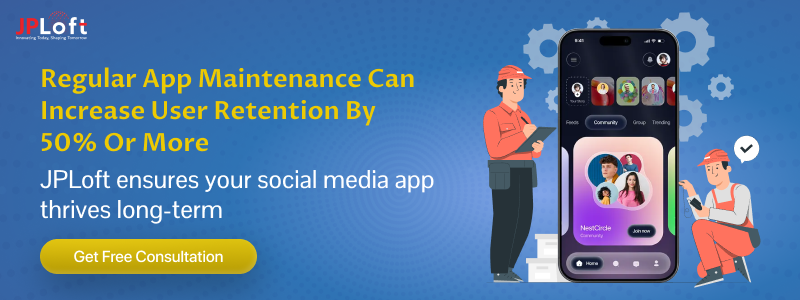Building a social media app is one thing. Keeping it running smoothly is a whole different game. Users expect fast, secure, and glitch-free experiences 24/7. That’s why maintenance isn’t optional; it’s essential.
In this social media app maintenance guide, you’ll learn how to maintain a social media app the right way. From feature updates to AI-powered tools, we’ll walk you through everything you need to know to keep your app healthy, competitive, and user-friendly in 2025.
Whether you're a startup founder, product manager, or tech lead, this complete guide to maintain a social media app is your shortcut to mastering ongoing upkeep without burning out your dev team.
Key Takeaways
Ongoing social media app maintenance is critical to ensure fast performance, robust security, and consistent user engagement in social media apps post-launch.
Key areas to monitor include core functionality, app security, performance optimization, software updates, and user analytics.
There are five types of maintenance: corrective, adaptive, perfective, preventive, and predictive each playing a role in long-term app health and user satisfaction.
AI-powered tools for maintaining social media apps can automate bug detection, predict failures, analyze feedback, and optimize performance.
Online social media app maintenance costs typically range from 15–25% of the initial app development cost annually and should be planned from the outset to avoid future scalability issues.
What Is a Social Media App? Quick Overview with Stats
A social media app is a digital space where users can share content, connect with communities, and engage in real-time conversations. These platforms go beyond likes and shares; they power commerce, entertainment, education, and even job discovery.
Now, let’s quickly explore the current landscape of social media apps through stats and trends.
-
- As of 2025, there are approximately 5.24 billion social media users globally, representing around 63% of the world’s population.
- The average user spends about 2 hours and 21 minutes daily on social media platforms, showing how deeply these apps are woven into everyday life.
- Among the best social media apps, Instagram, TikTok, LinkedIn, and Facebook continue to lead in active users, features, and global influence.
- The rise of AI curation, creator tools, and short-form video are just a few standout social media app development trends shaping how new platforms are being built.
With usage stats like these, it's clear that social media apps are no longer optional; they’re essential to how the modern world communicates, consumes, and connects.
Why Maintain a Social Media App? Here’s What Happens If You Don’t
Think building a social media app is a one-and-done project? Not quite. Once your app goes live, that’s when the real work begins.
Why maintain a social media app? Because users expect lightning-fast performance, bug-free functionality, updated features, and rock-solid security all the time. If your app starts lagging or feels outdated, users won’t stick around.
Here’s exactly what can go wrong without regular social media app maintenance:
► Downtime Frustrates Users
A slow or crashing app is the fastest way to lose users. Regular updates keep your app stable, secure, and functional.
► Outdated Features Drive Users Away
Your competitors are rolling out new features constantly. If you don’t evolve, users will move on to better experiences.
► Security Vulnerabilities Build Up
Skipping maintenance opens the door to cyberattacks. Frequent patches protect user data and your platform’s integrity.
► You Lose Revenue Opportunities
The way how social media apps make money depends heavily on engagement. If users bounce, your ad and subscription revenue tank.
► Reputation Takes a Hit
One bad app store review can cost thousands of potential users. Neglect leads to performance dips and public backlash.
Therefore, apps that skip updates often end up being classic examples of why social media apps fail. Long story short: maintenance isn’t optional. It’s your insurance policy for user trust, growth, and profitability.
What Are the Main Areas of Social Media App Maintenance?
Regular social media app maintenance goes far beyond fixing bugs. It involves regularly fine-tuning every part of your app to ensure a seamless user experience, stable performance, and secure operation.
Whether it's about android app maintenance or iOS app maintenance, you need to evaluate the key areas to maintain these apps.
1. Core Features & Functionality
Your app’s core experience—posting, messaging, liking, and sharing—must be seamless. Bugs in these features directly affect engagement and retention. Continuous testing and refinement are essential to avoid disruptions that frustrate users or make your app feel outdated.
Explore how essential social media app features evolve with user expectations.
2. App Security
Security threats like data breaches or unauthorized access can instantly damage brand credibility. Therefore, regular updates to authentication systems, encryption layers, and third-party API permissions are vital. Solid social media app security builds trust and meets regulatory standards like GDPR or CCPA.
3. Performance & Speed Optimization
Even a one-second delay in app response can increase bounce rates. Maintenance ensures optimized server response times, resolved memory leaks, and improved database queries. It also involves load testing your backend to prepare for traffic spikes or content surges.
4. Software Updates & Compatibility
Both Android and iOS push regular OS changes that affect app behavior. Therefore, ensuring compatibility with new screen sizes, gestures, and hardware optimizations helps avoid app crashes or user friction. Also, keeping SDKs and libraries updated ensures smoother app performance.
5. Analytics & User Behavior Tracking
Ongoing maintenance includes ensuring that your app’s analytics tools are functioning properly. Tracking key user flows, drop-off points, session durations, and engagement patterns helps you make informed updates and identify which features need improvement or removal.
Regularly maintaining these areas not only improves user satisfaction but also extends the life and profitability of your app.
What Are the Different Types of Social Media App Maintenance?
Maintaining a social media app isn't just about fixing bugs; it's about adapting to change, preventing problems, and improving continuously. There are several types of maintenance, each playing a key role in keeping your app secure, stable, and competitive.
Let’s break down the main types of social media app maintenance:
1] Corrective Maintenance
This involves identifying and fixing bugs, crashes, or performance issues after they’ve occurred. It’s reactive and typically triggered by user complaints, QA findings, or monitoring systems. Think of it as the app equivalent of patching a flat tire.
2] Adaptive Maintenance
When platforms like Android or iOS update their OS, your app must adjust accordingly. Adaptive maintenance ensures compatibility with third-party tools, libraries, and new hardware. For example, after major updates that impact UI behavior like the kind seen in Skype alternatives, this form of upkeep is essential.
3] Perfective Maintenance
Perfective maintenance focuses on refining features based on user feedback and evolving market trends. You might improve navigation flow, simplify onboarding, or enhance a content feed. Many Discord alternatives are constantly evolving via perfective updates to match user expectations.
4] Preventive Maintenance
This type is all about reducing the risk of future failures. It involves reviewing log files, cleaning up old code, or optimizing queries before any issue arises. Preventive maintenance is like regular health checkups; it keeps your app strong behind the scenes. In case of handyman app maintenance, and astrology app maintenance, this type leads.
5] Predictive Maintenance
Using data analytics and monitoring tools, predictive maintenance aims to foresee potential problems before they occur. It’s a more proactive and AI-driven approach that helps reduce downtime and boost reliability.
Each type of social media app maintenance plays a strategic role in keeping your app usable, secure, and ahead of competitors. Ignoring even one can lead to compounding issues down the road.
How to Maintain a Social Media App: Step-by-Step Process
Whether it's about music app maintenance, fuel delivery app maintenance, or for any other industry, you need to know the process to maintain an app.
Maintaining a social media app is an ongoing cycle, not a one-time task. It requires a strategic mix of planning, testing, optimizing, and evolving your app to keep users engaged and systems running smoothly.
Below is a step-by-step guide to maintain a social media app effectively.
Step 1: Create a Maintenance Roadmap
Start by defining how often each component of your app will be checked or updated; this includes features, backend systems, and third-party APIs. A clear roadmap prevents chaos and helps track tasks across your dev team.
Step 2: Monitor App Performance Continuously
Use performance tracking tools to monitor response time, crash rates, and memory usage. These insights are critical in avoiding the kinds of issues that often trigger social media app development challenges like lag, downtime, or user drop-offs.
Step 3: Conduct Regular QA Testing
Frequent testing across different devices, operating systems, and network conditions helps catch bugs early. Include both manual and automated testing in your cycle to ensure stability after every new release or third-party integration.
Step 4: Collect and Analyze User Feedback
Monitor app store reviews, in-app feedback, and behavior analytics to understand what’s working and what’s not. This feedback loop helps prioritize improvements and perfect features that matter most to users.
Step 5: Upgrade UI/UX Based on Trends
User expectations evolve fast. Refresh the app’s design to stay current with visual trends and usability standards. If you’re unsure where to start, revisit the principles of how to design a social media app to guide your UX updates.
Step 6: Implement Security Updates and Compliance Checks
Schedule regular checks for new vulnerabilities and update your app accordingly. Ensure your app is compliant with data privacy laws like GDPR or CCPA to avoid penalties and protect your user base.
Step 7: Update Code Libraries and APIs
Deprecation of third-party tools or outdated SDKs can cause sudden app failures. Keep libraries, frameworks, and integrations updated to ensure long-term compatibility and better performance.
Also known as practical tips to maintain a social media app, these steps can drastically reduce churn and improve the experience.
Can You Maintain a Social Media App with AI? Here’s How
Absolutely, AI is rapidly transforming how social media apps are maintained. From predicting issues before they happen to automating bug fixes, AI simplifies and streamlines the entire maintenance cycle.
Here are a few ways you can maintain a social media app using AI:
A] Predictive Maintenance with AI Models
AI can analyze system logs and usage patterns to detect anomalies and predict system failures. This allows your team to proactively fix issues before users even notice them.
B] Automated Bug Detection & Resolution
With machine learning algorithms, AI can scan through lines of code, test builds automatically, and identify patterns that typically result in crashes or UI glitches, helping reduce manual QA load.
C] Sentiment Analysis for User Feedback
AI can analyze app reviews, social media mentions, and in-app feedback to detect rising complaints or trends. This allows faster prioritization of updates based on real user sentiment.
D] AI for Load Testing and Performance Monitoring
AI can simulate thousands of user sessions to test server performance under different conditions. These insights help optimize your app’s speed, load time, and server scalability.
E] Smart Recommendations for Feature Updates
AI tools analyze user behavior to suggest improvements in design, navigation, and feature usage. These insights are key when planning updates, especially if you aim to create an AI app; these tips to maintain a social media app become even more essential.
If you’re exploring automation in app upkeep, partnering with an experienced AI app development company can help integrate these tools seamlessly. They can develop custom solutions tailored to your platform’s size, tech stack, and long-term goals.
How Top Social Media Apps Handle Maintenance: Case Studies
Ever wonder how big social platforms stay stable, relevant, and glitch-free despite millions (or billions) of users? The answer lies in consistent, strategic app maintenance.
Let’s explore how some of the top social media apps maintain their platforms—and what you can learn from them.
Case Study 1: Instagram: Fast Iterations and Performance First
Instagram focuses heavily on UI/UX refinement, machine learning integration, and performance monitoring. They roll out A/B-tested updates weekly and invest in predictive analytics to avoid slowdowns. With such a complex infrastructure, the cost to develop an app like Instagram is high, but the investment in maintenance is even higher.
Case Study 2: Snapchat: Real-Time Infrastructure and Modular Updates
Snapchat constantly optimizes for real-time video, AR filters, and chat features. They break their backend into modules to push updates without affecting the entire app. Their focus on innovation and uptime makes them tough competition among Snapchat alternatives trying to match their pace.
Case Study 3:MeWe: Privacy-Centric and Lightweight Maintenance
MeWe has built its reputation around privacy and simplicity. Their team ensures fast security updates and minimalistic feature optimization. For brands building with a privacy-first mindset, understanding the cost to develop an app like MeWe includes budgeting for frequent data compliance checks.
What You Can Learn From These Leaders
-
Adopt modular backend structures for smoother, safer updates
-
Use user data (ethically) to guide perfective and predictive changes
-
Prioritize speed, security, and adaptability—no matter your app size
Even if you're not Instagram-level big (yet), applying these principles can drastically improve your app’s uptime, security, and user satisfaction.
How Much Does Social Media App Maintenance Cost in 2025?
So, you've launched your social media app. But how much will it cost to keep it running smoothly?
On average, the social media app maintenance cost ranges between 15% and 25% of your app’s initial development cost per year.
That means if your app costs $100,000 to build, expect to spend around $15,000–$25,000 annually on updates, monitoring, and improvements.
Let’s evaluate the factors impacting the mobile app maintenance cost in the following segment.
Key Factors That Influence Maintenance Cost
Here are some of the key factors that affect social media maintenance cost:
1. App Complexity
A feature-rich platform with feeds, messaging, notifications, and real-time sync requires more effort to maintain than a basic networking app.
2. User Base Size and Server Load
The more users you have, the more server resources, scaling, and performance monitoring you’ll need. As traffic grows, so does the maintenance budget.
3. Frequency of Updates and Feature Enhancements
If you're constantly rolling out new features to stay competitive, you’ll need ongoing QA, design adjustments, and backend optimization.
4. Security Monitoring and Compliance
Apps handling sensitive user data (e.g., location, payment, or personal info) need ongoing security checks and legal compliance updates, especially with global privacy laws.
5. In-House vs. Outsourced Maintenance
Hiring an in-house team may offer control but increases overhead, while outsourcing to experts can save costs, especially when working with the best mobile app development company.
Pro Tip: Budget Smart from Day One
Many entrepreneurs ask how to start a social media business without factoring in maintenance. But skipping this step leads to buggy updates, poor UX, and faster user drop-off. Build your roadmap with post-launch costs in mind.
Typical Monthly Maintenance Range (2025)
|
App Size |
Estimated Monthly Cost |
|
Basic App |
$1,000–$2,000 |
|
Mid-Level App |
$2,500–$4,000 |
|
Advanced/Scaled App |
$5,000 – $10,000+ |
While the upfront social media app development cost grabs attention, smart businesses know that consistent maintenance is what truly sustains success.
What Are the Biggest Challenges in Maintaining a Social Media App?
Maintaining a social media app isn’t always smooth sailing. Even the best apps face hurdles that, if not addressed, can lead to performance dips, user churn or even complete failure.
Here are some key social media app maintenance tips that help address these common challenges:
► Evolving Security Threats
Cyberattacks, data breaches, and API vulnerabilities constantly evolve. Keeping up with encryption standards, third-party patching, and compliance updates is a never-ending task and falling behind can lead to data loss or PR disasters.
► Technical Debt and Outdated Code
Over time, temporary fixes and rapid releases pile up as tech debt. This clutters your codebase, making maintenance harder and slower. Without regular refactoring, even small updates can trigger bigger problems.
► High User Expectations
Users expect fast, intuitive, and glitch-free experiences. Even minor bugs in features like DMs, notifications, or feeds can spark negative reviews. Constantly meeting rising expectations while innovating can stretch dev teams thin. That’s why many teams hire dedicated developers to ensure long-term support, bug fixes, and rapid iteration.
► Keeping Up with Platform & Device Changes
iOS and Android release frequent OS updates that impact performance, UI behavior, or privacy handling. Not adapting quickly can break parts of your app or make you seem outdated.
► Scaling Maintenance for Growth
As your user base grows, so do performance bottlenecks, server demands, and analytics complexity. Without the right infrastructure or monitoring tools, growth can expose weak spots fast. That’s where working with the top mobile app development companies in the USA gives you an edge; they’re equipped to manage performance, scaling, and maintenance at every level.
If these issues are ignored or handled reactively, it can lead to degraded app performance and user loss. In fact, many of these reasons should be considered right from the planning stage, especially if you're exploring how to create a social media app and want to avoid common post-launch pitfalls.
Why Choose JPLoft to Maintain Your Social Media App?
When it comes to maintaining a social media app, you need more than just routine bug fixes; you need a proactive tech partner. At JPLoft, we’ve helped startups and enterprises around the world scale their platforms with secure, seamless, and future-proof maintenance services.
From performance optimization and real-time monitoring to compliance updates and AI integration, we handle it all under one roof.
As a leading social media app development company, we don’t just build apps; we keep them evolving with your users' expectations.
Whether you're running a small community app or a global-scale social network, our dedicated team ensures your platform stays relevant, reliable, and ready for what's next.
Let’s keep your app running at its best; partner with JPLoft today.
Conclusion
Let’s be honest, launching a social media app is just the beginning. The real challenge (and opportunity) lies in how well you maintain it.
From bug fixes and performance tuning to adapting to tech trends and user demands, consistent maintenance is what separates thriving apps from those that fade out.
If you're serious about long-term growth, follow this social media app maintenance guide and invest in a roadmap, team, and tools that future-proof your platform.
Because a well-maintained app doesn’t just survive, it leads.
FAQs
A well-maintained app ensures stable performance, security, compatibility with OS updates, and an evolving user experience. Regular maintenance prevents bugs, boosts retention, and keeps your platform competitive.
Ideally, every 2–4 weeks. Frequent updates allow for timely bug fixes, feature enhancements, and adaptation to user feedback or platform changes.
Costs typically include server hosting, API management, bug fixes, security patches, version updates, and occasional feature upgrades. Maintenance expenses usually range from 15% to 25% of your app’s original development cost annually.
Absolutely! AI can automate bug detection, optimize content delivery, improve moderation, and even predict performance bottlenecks, making maintenance more efficient and proactive.
It depends on your resources. In-house teams offer direct control, while outsourcing to experienced app maintenance partners can save costs and ensure professional support at scale.
Expect declining performance, increased bugs, security risks, and reduced user satisfaction. Without maintenance, even the most successful app can lose users and revenue fast.













Share this blog